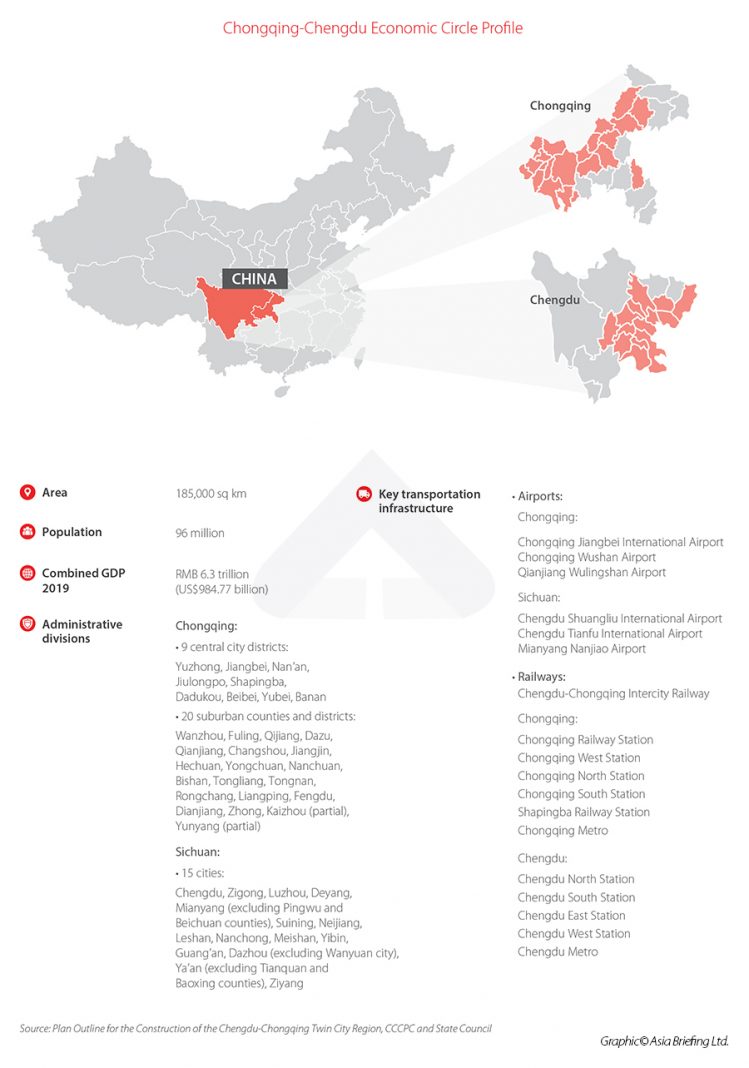
On October 21, 2021, the Central Committee of the Communist Party of China (CCCPC) and the State Council jointly issued the Plan Outline for the Construction of the Chengdu-Chongqing Twin City Region (the ‘plan’), an extensive document detailing a new plan to create a new city cluster in China’s western regions. First announced in 2019, the project aims to address developmental imbalances by integrating two of the most economically active cities in western China – Chongqing and Chengdu – into a mega-city cluster, focusing on developing key infrastructure and industries.
The new Chengdu-Chongqing Twin City Region (‘Twin City region’) will be the fourth such economic cluster to be built in China and the first in the west of the country, following the Beijing-Tianjin-Hebei (BTH) region in the north, the Yangtze River Delta (YRD) region in the east, and the Guangdong-Hong Kong-Macao Greater Bay Area (GBA) in the south.
The latter three economic clusters have overseen an explosion in economic activity in their respective regions, and today represent some of the wealthiest regions in mainland China. If successful, the Twin City region will help to cultivate new opportunities for an area with considerable developmental potential, while greatly facilitating the movement of people and goods across the region. It will also help create an ‘economic corridor’ to access more remote and isolated parts of China, such as Tibet and northwestern China.
Overview of the Twin City region
The Twin City region covers an area of 185,000 sq km. It includes all of the nine districts in the Chongqing city center and a further 20 suburban districts and counties, mostly those bordering Sichuan Province to the west and northeast of the city center, but also a few to the south and east.
In Sichuan, the region covers the provincial capital of Chendu, and 14 sub-provincial cities (excluding a few city districts) mostly clustered in the eastern part of the province toward Chongqing. It includes Mianyang, the second-largest city in Sichuan and an emerging technology hub, as well as the major manufacturing cities of Nanchong and Deyang.

The combined area is home to 96 million people and reached a combined GDP of RMB 6.3 trillion (US$984.77 billion) in 2019, according to the introduction to the plan.
By comparison, the GBA covers an area of 59,900 sq km and was home to 73 million permanent residents as of 2019. The region recorded a GDP of RMB 11.58 trillion (US$1.8 trillion) and a per capita GDP of RMB 161,500 (US$25,267) in 2019. The YRD region, meanwhile, the largest of the four city clusters, covers an area of 358,000 sq km and houses 227 million people. The region registered a GDP of RMB 23.7 trillion (US$3.7 trillion) and a per capita GDP of RMB 104,452 (US$16,342) in 2019.
RELATED SERVICES
- GAIN INTELLIGENCE ABOUT DIVERSIFYING YOUR SUPPLY CHAIN IN CHINA WITH OUR BUSINESS INTELLIGENCE SERVICES
With a per capita GDP of RMB 58,333 (US$9,126) in 2019, the Twin City region falls far below that of the other city cluster regions, and also below the national average of RMB 70,892 (US$11,091).
The distribution of wealth is also not equal across the region. Chongqing accounted for 37 percent of the Twin City region’s GDP, a higher proportion than Chengdu, even though Chengdu is far better connected to its surrounding cities than Chongqing is. Improving connectivity, both logistics and economic, between the two cities could therefore serve to better distribute wealth and opportunities across the region.
Main targets for the Twin City plan
The plan provides a blueprint for further integrating the industries and infrastructures of the two regions and developing their respective economies. These include plans to expand the transport network to better connect various cities and counties, both within the region and beyond, as well as upgrading and expanding key infrastructures, such as telecom and utilities.
In addition, the plan provides a vision for the development and expansion of key industries, most notably manufacturing, modern services, and high-end technology.
The plan also proposes specific goals to achieve by 2025. These include:
- Reaching a 66 percent urbanization rate of the permanent population.
- Building an intercity railway enabling one-hour travel between Chongqing and Chengdu.
- Expanding the railway network to cover 9,000 km in total and connect all cities with a population of over 200,000.
- Building a shipping and logistics center for the upper reaches of the Yangtze River.
- Expanding 5G coverage to cities, towns, and key settings.
- Investing approximately 2.5 percent of GDP in R&D.
Below we provide a brief overview of some of the plans for the transport network, infrastructure, and industry development.
Integrating and expanding transport infrastructure
Rail
One of the key goals of the plan is to realize the ‘1-hour city circle’, a vision that would enable people to commute between the major cities in the region in just one hour and thereby make it feasible for people to work in one city and live in another.
At present, it takes multiple hours to travel between Chongqing to Chengdu by public transport. (Note that some high-speed trains traveling between Chongqing and Chengdu take only one hour, but they are relatively irregular and expensive, and the door-to-door travel time would amount to much longer in practice for the majority of commuters).
The plan also proposes creating a unified public transport system in the region to enable passengers to use the same transport card or payment mechanism to take multiple means of transport in different cities and districts across the region.
In addition to inter-city railways, the plan also proposes the expansion of multiple inter-provincial railroads, including new railway lines running south from Chongqing to the city of Kunming in Yunnan Province, a railway running west from Chengdu to the Qinghai capital of Xining, and the construction of the Sichuan-Tibet railway. These inter-provincial railways would serve to strengthen the region’s position as an ‘economic corridor’ and key hub for the transport of goods across the country, as well as opening up new trade routes with remote parts of the country.
Air
In addition to railways, the plan seeks to expand the capacity of existing airports, build new airports in smaller cities, better integrate the operations of different city airports, and link them with city railway networks.
Among these are plans to expand the Chongqing Jiangbei International Airport, as well as a proposal to build a second international airport in the city, although the plan does not provide specific details on how and when this should be done.
In addition, new branch airports have been proposed for the cities of Leshan, Suining, and Ya’an, and the Langzhong district in Nanchong city.
In Chengdu, the plan similarly proposes the expansion of the city’s Shuangliu International Airport. It also calls for integrating operations with the newly opened Chengdu Tianfu International Airport, and proposes improving the airport collection and distribution system and exploring new technologies and models for combined air and rail transportation.
Upgrading the manufacturing industry
As is the case in many areas across China, economic development in Sichuan and Chongqing has been largely driven by manufacturing. Although the two cities’ economies have are shifting inexorably toward the service industries, secondary industries still have an important role to play. 40 percent of Chongqing’s GDP in 2020 still came from manufacturing industries; for Chengdu, it was just over 30 percent. This is even more true for smaller prefecture-level cities: Mianyang, the second-largest city in Sichuan, derived over 44 percent of its GDP from manufacturing, compared to just over 43 percent from services.
The government is seeking to further spur the industry to drive economic growth, focusing on key traditional industries – such as auto and motorcycle components manufacturing – but also shifting gears to focus on new and emerging industries – integrated circuits, industrial robots, and CNC machine tools.
The plan offers a two-pronged approach to developing the industry, dividing different manufacturing sectors largely into the north and south of the region. In the north, the plan aims to integrate and develop industries such as the manufacturing of advanced materials, automobiles, and motorcycle accessories; in the south, the development will focus on F&B, equipment manufacturing, and energy and chemicals, among other industries.
The plan also outlines the creation of an ‘internationally competitive’ industry cluster driven by smart connectivity and new energy industries, calling to jointly build a high-level automotive industry R&D and manufacturing base. Other industries of interest are aerospace, rail transit, energy equipment, industrial robots, instrumentation, CNC machine tools, and motorcycle components.
Finally, the plan proposes the construction of new industrial development zones and further integration of existing industrial zones in the two areas. Newly built industrial zones would either cross provincial boundaries, such as across Guang’an city in Sichuan province and the Yubei district in Chongqing, or create individual ‘enclave’ parks in the other region’s jurisdiction.
Developing the digital economy
With the region shifting toward a service-oriented economy – especially in highly urbanized Chengdu – the government is keen to use its other key tool for boosting the economy – digital industries.
But first, in order to enable the digital industry to take off, the plan sets out goals for building the requisite infrastructure, which involves, among other goals, accelerating the construction of 5G networks, advancing optical fiber access networks, deploying next-generation Internet based on IPv6, and promoting national-level Internet exchange points for broadband expansion.
Meanwhile, the plan lays out a vision for the development of the digital industry, aiming to develop fields such as integrated circuits (ICs), new types of displays, and intelligent terminals. It also seeks to cultivate innovative applications, such as ultra-high-definition video, AI, blockchain, and digital creative industries, while promoting the upgrading and digitalization of traditional industries.
Developing modern services industry
Helping to tie together the services and manufacturing industries are several peripheral service sectors that the government is also keen to develop. These cover sectors such as R&D and design, technology services, business consulting, and human resources.
Among other sectors, the plan seeks to further strengthen Chongqing and Chengdu’s position as a logistics hub. The plan proposes to achieve this partially through the creation of a joint international freight center, as well as regional logistics centers in places such as the Sichuan prefecture-level cities of Zigong, Suining, and Dazhou and the Chongqing districts of Wanzhou and Fuling.
RELATED SERVICES
- OUR BUSINESS ADVISORY TEAM CAN HELP YOU OPTIMIZE YOUR OPERATIONS IN CHINA
The creation of a ‘western financial center’ is another one of the plan’s core goals. The plan envisions cultivating a wide range of financial services, including cross-border renminbi businesses, overseas renminbi investment funds, fintech, and green finance. The plan aims to further integrate the financial markets and regulatory jurisdictions of the different areas and promote cross-border cooperation in fields such as guarantees, venture capital, and private equity. The plan also calls for the creation of a bankruptcy court and improving the financial adjudication system, building up the regulatory and legal infrastructure to cultivate a healthy financial market.
The Chengdu-Chongqing region has huge economic potential. If the plan for the development of the Twin City region is implemented successfully, we can expect to see increasingly vibrant economic activity and the establishment of new industries and companies in the area.
This model for city integration has seen success in other regions of China, helping to build some of the most prosperous regions and cultivating some of China’s most innovative industries. The Twin City region also has a certain advantage over its coastal counterparts: its central location makes it an ideal hub from which to reach still-developing markets in western and northern China, and its lower labor costs may become increasingly attractive price-sensitive companies based in expensive coastal cities.
However, the plan in its current form does not provide concrete steps for how the government plans to achieve these goals. It also makes no mention of the role of foreign capital in the development of the region. The details for building the infrastructure and developing industries are likely to be hashed out in future policy documents aimed at specific industries and fields and may include outlines for participation by foreign companies and investors.
Foreign investors interested in tapping into the western China markets are therefore advised to keep a sharp eye on policy developments and updates, particularly as it relates to industrial pilot zones, as these are the areas that are most likely to seek foreign capital.
This article was first published by China Briefing, which is produced by Dezan Shira & Associates. The firm assists foreign investors throughout Asia from offices across the world, including in China, Hong Kong, Vietnam, Singapore, India, and Russia. Readers may write info@dezshira.com for more support.






